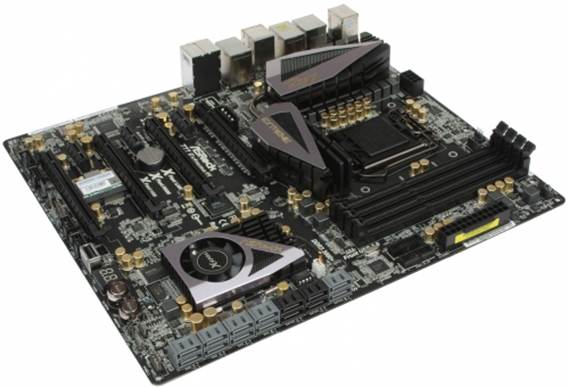PCB Design and Functionality
As we mentioned in the introduction, the
key feature of the ASRock Z77 Extreme11 is its 8 additional SATA6 Gbit/s ports.
The advantages of motherboard are not limited to them, though. Going beyond the
functionality scope of the Intel Z77 Express chipset, it carries many extended
controllers to implement more features.

It
brings a lot of extended controllers
A CPU installed into the mainboard’s
LGA1155 socket is powered by an advanced 8+4-phase Digi Power system which
employs gold solid-state capacitors and dual-stack MOSFETs. The PCB features
copper interconnects with increased thickness which is referred to as 2OZ
Copper PCB technology. The four memory sockets can accommodate up to 32
gigabytes of DDR3 SDRAM. Memory frequency can be set up to 3000 MHz in the
BIOS. The hot components of the voltage regulator are covered with an
additional heat sink which is connected with a heat pipe to the main heat sink.
The latter is mounted on a PLX PEX 8747 chipset that offers more 3.0 PCI
Express lanes. Thus, the LSI SAS2308 controller has enough bandwidth for all
eight SAS2/SATA3 ports. Along with six SATA ports provided by the chipset (two
SATA 6 Gbit/s and four SATA 3 Gbit/s), the mainboard allows you to connect up
to 14 drives!

The
mainboard allows you to connect up to 14 drives!
The PLX PEX 8747 offers much more PCIe 3.0
lanes than is necessary for the LSI SAS2308, so the remaining lanes are
employed for the mainboard’s multi-GPU support. Single graphics card will work
in PCIe 3.0/2.0 x16 mode at maximum speed. Two or three graphics cards will run
at 8x speed. The mainboard supports NVidia SLI and AMD CrossFireX. In the
latter case, you can even use the fourth socket in the PCIe 2.0 x4 mode. In
addition, there are three PCI Express 2.0 x1 sockets for expansion cards
whereas the mini-PCI Express socket was occupied by an Atheros AR5B22 card
which offers two Wireless interfaces: dual-band Wi-Fi 802.11a/b/g/n and
Bluetooth 4.0. There are plenty of connectors on the mainboard's back panel.

The
PLX PEX 8747 offers much more PCIe 3.0 lanes than is necessary for the LSI
SAS2308
·
Universal PS/2 connector for keyboard or mouse;
·
Eight USB 3.0 ports (blue connectors), four of
which are implemented via EtronTech EJ188H controller, four more ports are
supported by the Intel Z77 Express chipset, and a second Etron Tech EJ188H
controller delivers two on-board pin connectors for four additional USB 3.0
ports;
·
“Clear CMOS” button;
·
HDMI video out;
·
Two local network ports (network adapters are
built on Gigabit Intel 82583V and Intel 82579V network controllers);
·
Two USB 2.0 ports, another six are laid out as
three onboard pin-connectors;
·
IEEE1394 (FireWire) port implemented with VIA
VT6315N controller, a second port like that is available as an onboard
pin-connector;
·
eSATA 6 Gbit/s is combined with one of the
internal SATA 6 Gbit/s ports provided by the Intel Z77 Express chipset;
·
Optical S/PDIF and five analogue audio-jacks
provided by eight-channel Realtek ALC898 codec.
The Intel Z77
Express offers but a limited number of free PCI Express 2.0 lanes, so there is
an additional PLX PEX 8608 bridge, which supports eight PCI Express 2.0 lanes,
helping to connect multiple controllers and mainboard sockets. In addition, we
can generate 7 fan connectors, one of them is used for the chipset's fan. There
are two CPU fan connectors, one of which is 4-pin type, the rest are 3-pin
type, so the CPU can be adjusted regardless of the type of its connector. In
addition to the Clear CMOS button that we saw on the back panel, there are
Power and Reset buttons, a POST indicator, and one vertical USB 2.0 header
(type A). The memory modules have handy latches on one side but the latches of
the graphics slots are small and not easy to use.